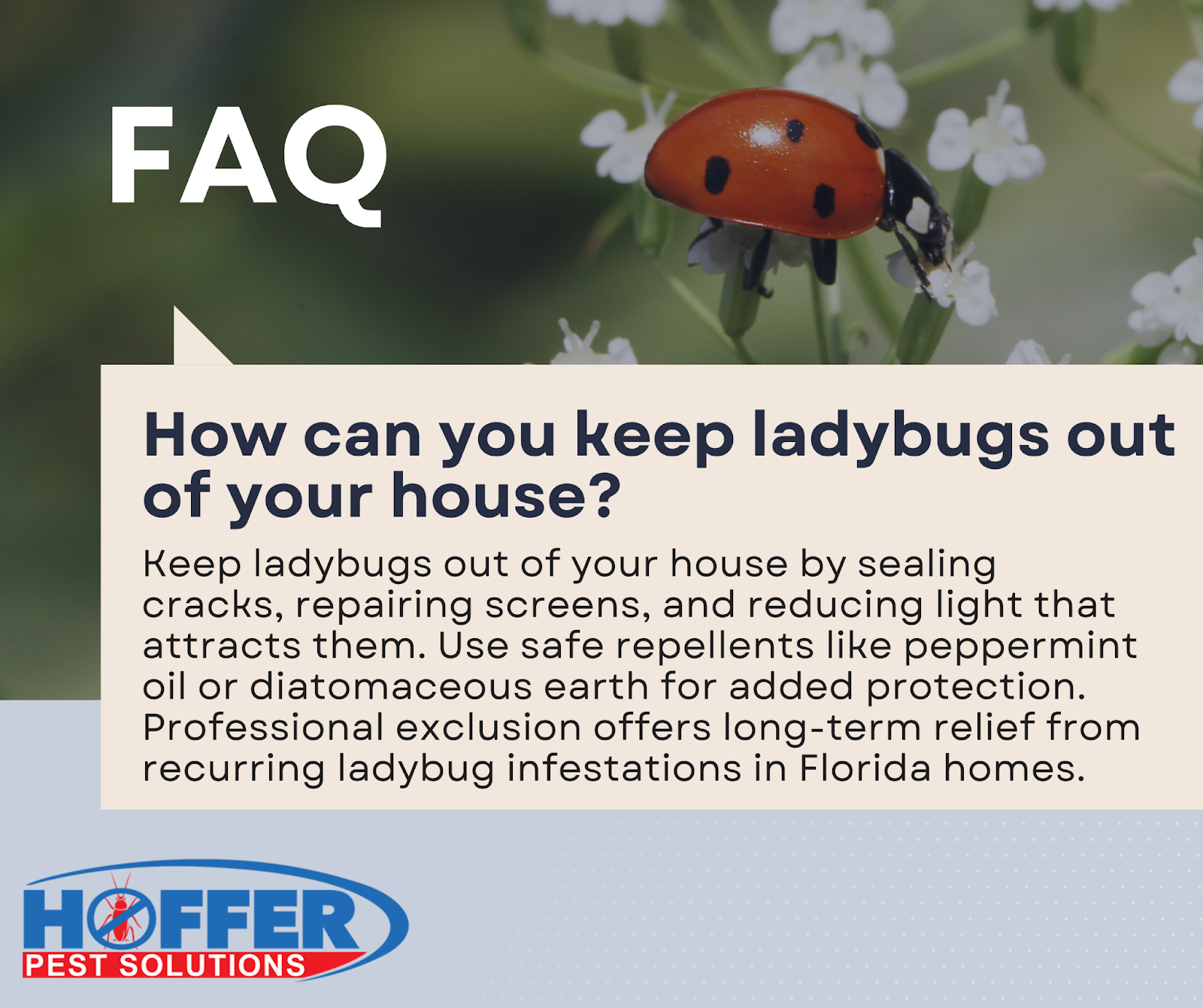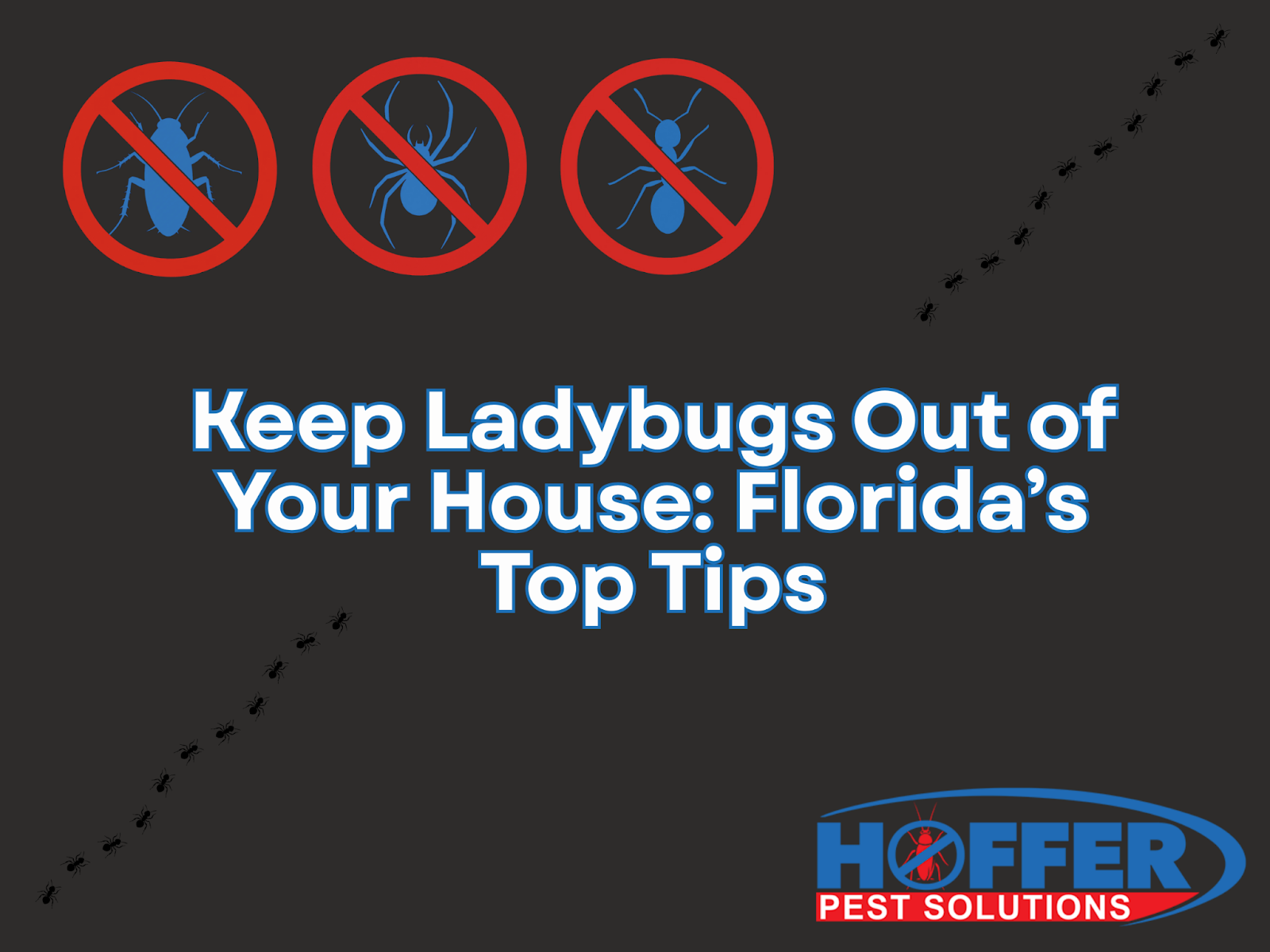Keep ladybugs out of your house by sealing cracks, repairing screens, and reducing light that attracts them. Use safe repellents like peppermint oil or diatomaceous earth for added protection. Professional exclusion offers long-term relief from recurring ladybug infestations in Florida homes.

Finding a couple of ladybugs indoors can feel harmless, even lucky. But when dozens appear on your walls or windows, it’s clear you’ve got a problem. These beetles, often invasive Asian lady beetles rather than true ladybugs, enter Florida homes in search of warmth, leaving behind stains, odors, and frustration.
The good news is, you don’t have to put up with them. With the right prevention strategies, sealing entry points, limiting light attractants, and using safe repellents, you can drastically reduce the chance of an infestation. And if swarms keep coming back, professional exclusion offers a permanent fix.
Hoffer Pest Solutions specializes in helping Florida homeowners protect their homes with proven, eco-friendly solutions. If you’re tired of dealing with ladybugs year after year, our team has the tools and expertise to help.
Below, we’ll break down exactly why ladybugs invade, how to stop them, and when it’s time to call in a professional.
Proven Ways to Keep Ladybugs Out of Your House
Seal and Exclude Entry Points
The single most effective defense against ladybug invasions is exclusion. Start by sealing cracks in siding, repairing torn window screens, and replacing worn weatherstripping. In Florida’s humid climate, water damage often creates hidden entry routes for pests. Repairing these weak spots helps keep beetles out and also strengthens your home against other insects and rodents. Homeowners frustrated by recurring infestations often discover that no amount of vacuuming helps until these openings are addressed.
Reduce Attractants Around Your Home
Light and landscaping play bigger roles than most people realize. Since beetles are drawn to brightness, limiting outdoor lighting or switching to motion-sensor bulbs reduces attraction. In the yard, overgrown vegetation near siding acts as a highway for pests. Keeping shrubs trimmed and storing firewood away from your house makes it harder for beetles to gather near entry points. Even your choice of plants can help, chrysanthemums, for instance, naturally repel beetles and can be placed near decks, windows, and entryways to discourage them.
Use Safe, Natural Repellents Indoors & Outdoors
For homeowners who prefer natural options, essential oils such as peppermint, citrus, clove, and orange oil can help deter beetles when diluted with water and sprayed along windowsills or baseboards. Sprinkling food-grade diatomaceous earth near entry points makes it unpleasant for beetles to cross, while remaining safe for people and pets. Indoors, a vacuum is still the easiest way to remove clusters, and the sock-over-the-hose trick allows you to catch and release them without crushing.
That said, it’s worth noting that sprays and repellents provide short-term relief. Peppermint and neem oil may temporarily push beetles back, but exclusion, physically keeping them out, is the only way to ensure they don’t return next season.
How Ladybugs and Asian Lady Beetles Get Into Your Home
Once cooler weather settles in, these beetles look for tiny cracks and crevices around your house to slip through. Common entry points include siding gaps, attic vents, utility lines, and worn-out window screens. Even the smallest space can become a doorway to hundreds of beetles.
Florida homeowners often notice that beetles cluster near exterior walls with direct sunlight or around bright indoor light sources. LED bulbs in particular seem to draw them, which explains why they hover near fixtures and windows at night.
Another overlooked issue is wall cavities. Asian lady beetles are notorious for slipping into voids inside drywall or attic spaces, where they remain hidden until warmer weather. This hidden nesting makes infestations feel worse than they appear, feeding the worry that there’s a larger problem lurking behind the walls.
What NOT to Do When Dealing With Ladybugs
A common mistake is crushing beetles against walls or drapes. Doing so releases a yellow fluid that stains fabric and leaves behind a strong odor that lingers for months. Another misstep is turning to bug bombs or heavy insecticides indoors. These are unsafe for families and pets, and they rarely solve the issue. Beetles tend to scatter into other parts of the home when exposed to foggers, making the problem harder to manage. A third error is sealing them inside once they’ve already entered. Blocking vents, windows, or cracks without removing the beetles first can trap large numbers in hidden spaces, leading to foul odors and even attracting other pests.
Are Ladybugs Dangerous to People or Pets?
Ladybugs don’t chew wood or damage furniture. The invasive Asian lady beetle, however, brings more complications. These beetles can nip when handled and release a foul-smelling secretion that stains walls. Worse, if a curious pet swallows them, the beetles can stick to the roof of their mouth, causing drooling, gagging, or discomfort that often leads to a quick trip to the vet.
While infestations don’t threaten your home structurally, they do take a toll emotionally. For many families, the sight of dozens of beetles crawling across ceilings or walls creates stress far greater than the actual physical risk. Knowing how to respond safely and effectively helps ease that frustration and restores peace of mind.
Why Ladybugs Keep Coming Back Every Year
Asian lady beetles leave behind pheromone trails, chemical signals that tell other beetles your home is a good winter hiding spot. Those trails can linger for years, which explains why infestations often feel like a recurring cycle.
It’s key to understand that ladybugs and Asian beetles aren’t reproducing inside your home during the winter. They don’t lay eggs indoors; they’re simply hibernating. That means the beetles you see in late winter or early spring are the same ones that sneaked inside months earlier. Without proper exclusion, however, new beetles will return season after season, following the scent markers left by their predecessors. The only permanent solution is sealing your home so they have no way in.
Florida-Specific Challenges with Ladybugs
Florida’s warm, humid climate creates unique challenges for homeowners. Unlike colder climates where pests slow down during winter, the subtropical environment allows insects to stay active year-round. That means exclusion and prevention need to be part of your home maintenance plan year-round. Get in touch with us and we will take care of the rest.
Homes with stucco cracks, wood siding, or structural water damage are especially vulnerable to beetle entry. The moisture creates small gaps that beetles exploit, while shaded vegetation around the house makes it easier for them to gather. South Florida’s climate may also alter beetle behavior, with some infestations lasting longer than in northern states. Local experience and preventative strategies are especially valuable here.
When to Call a Professional Pest Control Company
DIY methods work for occasional sightings, but there are times when professional help makes all the difference. You should consider calling in the professionals if:
Beetles are consistently showing up in walls, attics, or hidden areas.
Swarms reappear each year despite your efforts to seal and clean.
Pets are affected after swallowing beetles or reacting to stains and odors.
Exclusion performed by trained professionals is far more effective than DIY sealing. Pest control teams use specialized materials and techniques to close off tiny access points most homeowners overlook.
Hoffer Pest Solutions has been helping Florida families for more than 40 years. Our team focuses on proven exclusion strategies tailored to the unique challenges of South Florida homes. Because we live and work in the same communities we serve, we understand how pests behave here and what it takes to stop them. We also prioritize eco-friendly methods that protect your home without unnecessary chemicals.
For homeowners struggling with recurring infestations, professional exclusion is about restoring comfort and peace of mind.
Keep Your Florida Home Ladybug-Free
While ladybugs and Asian beetles don’t threaten your home’s structure, the frustration they cause is very annoying. From stains and odors to the emotional stress of repeated infestations, it’s a problem best solved with long-term prevention. By sealing entry points, reducing attractants, and avoiding quick fixes like bug bombs, you can greatly reduce the chances of beetles invading your home.
And when the problem becomes too much to handle alone, that’s where we step in. We’re a family-owned company committed to protecting homes in South Florida. Our exclusion-based approach means you can finally break the cycle and enjoy your home without the stress of unwanted guests.
If swarms keep returning, our Hoffer Pest Solutions team can help you reclaim your home with proven exclusion and prevention strategies. Call today for a free inspection, and let us help you enjoy the peace of mind you deserve.
Frequently Asked Questions (FAQ)
What time of year are ladybugs most likely to invade homes in Florida?
Ladybugs and Asian lady beetles typically become a problem in late fall as temperatures drop, but in Florida, mild winters mean activity can extend into early spring. They’re most likely to gather on sunny walls and then slip indoors to hibernate.
Do ladybugs damage indoor plants?
No, ladybugs don’t feed on houseplants. They primarily eat aphids and other small garden pests outdoors. Inside, they’re only looking for a warm place to shelter, not food.
Can ladybugs cause allergies or health issues for people?
While most people don’t react to them, some individuals may experience mild allergic symptoms such as eye irritation or respiratory discomfort if exposed to large numbers. Asian lady beetles are more likely to trigger these reactions than native ladybugs.
How can I get rid of the smell left behind by crushed beetles?
That yellowish secretion, called hemolymph, can leave strong odors and stains. Cleaning stained surfaces with a mixture of mild soap and white vinegar usually helps. For porous materials like fabrics, an enzyme-based cleaner is more effective.
Do professional treatments eliminate ladybugs permanently?
There’s no pesticide that permanently eliminates ladybugs, but professional exclusion work, sealing cracks, repairing siding, and addressing structural issues, provides long-term relief. With this approach, most homeowners only need occasional follow-ups instead of facing infestations year after year.


